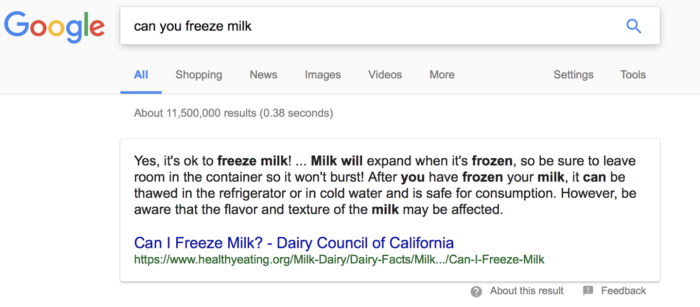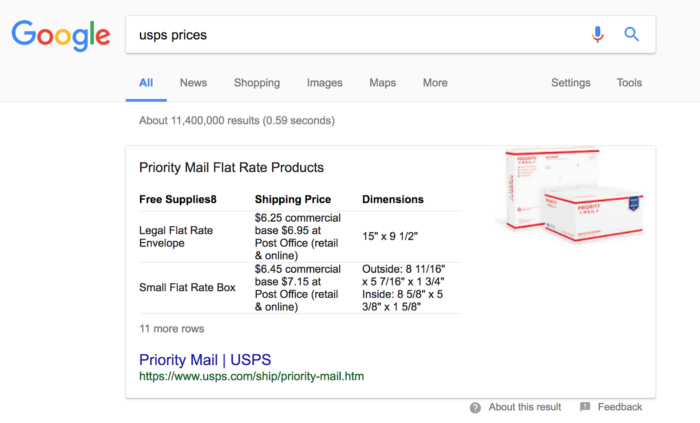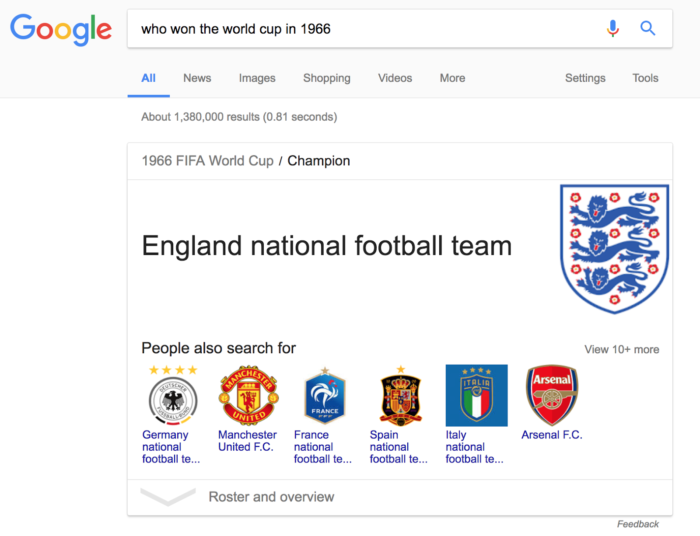- What Are Featured Snippets?
- Various Types of Google Featured Snippets
- Identify Potential Opportunities to Rank in Google Featured Snippets
- Using Search Console to find featured snippet opportunities
- Research Questions People Are Asking
- Combine Your Keywords with Answers to Popular Questions
- How to Format Your Post to Optimize It for a Snippet
- Don’t Forget About Backlinks
- Takeaways
[toc]If you’re looking for more website traffic and brand exposure, there’s a treasure chest right in front of you just waiting to be opened– ranking in Google’s featured snippets.
Imagine having a piece of prime real estate on Google, all to yourself. Now, imagine that luxury search engine beach-house is parked on a search term that can bring leads and sales pouring in for your business.
If your website is ranking in Google’s featured snippets, you’ll gain that piece of real estate in the search results!
Google’s featured snippets are those search results that appear prominently above the organic search results.
These snippets are Google’s way of showing users the exact information they’re looking for in the easiest, most prominent way possible.
Featured snippets present useful information right in the search results– so the user never even has to click multiple links to find it themselves.
When it comes to traffic from the first page of Google, the 1st organic search result has, on average, a 26% click-through rate.
But when there’s a featured snippet above that result, the 1st organic search listing’s traffic drops to 19.6%. That gives the featured snippet 8.6% of clicks.
In this blog post, we’re going to walk you through the steps you should take to optimize your content in a way that increases your chances of ranking in Google’s featured snippet. Are you ready to steal that extra traffic?
What Are Featured Snippets?
Featured Snippets are short peices of content that appear at the very top of Google’s search results. Some refer to these results as ‘Position 0′ and their goal is to quickly answer the users’ questions.
Various Types of Google Featured Snippets
There are three core types of featured snippets you should know about: paragraph, list, and table.
For example, if you were to try and rank for “Can you reheat rice?”, there is a 99.47% chance that a paragraph will show in the featured snippet.
 Depending on what you’re trying to rank for, will depend on the type of answer you should provide for your featured snippet.
Depending on what you’re trying to rank for, will depend on the type of answer you should provide for your featured snippet.
Paragraph Featured Snippets
Paragraph featured snippets are the most common. These are the ones that target the “who, what. where, how to” type questions.

List Featured Snippets
List featured snippets are most common with recipes, or results that require step-by-step instructions.

Table/data Featured Snippets
Table/data featured snippets tend to show information like pricing charts, or pie charts.

But take note, the featured snippet is not the same as the “quick answers” box. The quick answers box is shown when you ask factual questions like: 2+5.

Or “ Who won the world cup in 1966”

It should be noted that the most common topics to have featured snippets are financial, health, DIY, etc.
The featured snippet section is also related to the “People also ask” section of Google.
The “People also ask” section is a part of Google that shows similar questions users have asked based on the current search.

Clicking on a question in this section will show users a range of other featured snippet answers related to their current search.
When conducting your featured snippet research, paying attention to the “people also ask” section could be used to highlighting further featured snippet opportunities.
Identify Potential Opportunities to Rank in Google Featured Snippets
The first point to note when trying to identify potential featured snippet ranking opportunities is that most featured snippets are taken from the same content that already ranks #1-3 organically.
Luckily that presents you with two different options to rank for a featured snippet.
First, find content that you already rank #1-3 on Google and optimize that content for the featured snippet.
Second, you can create content with the featured snippet in mind.
Conducting keyword research should show you a range of different potential opportunities to rank in the featured snippet.
When conducting your keyword research, you should be either:
- Looking for keywords that don’t have a snippet.
- Seeking out opportunities to steal someone else’s snippet position
When doing keyword research, keep in mind that long-tail keywords, 4-6+ words or more tend to show more featured snippets than short phrases.
Using Search Console to find featured snippet opportunities
Google’s own tool, Search Console is a great way to identify featured snippet opportunities. Once you have a list of keywords and landing pages or blog posts that you’d like to rank, you’re good to go.
Access the Search Analytics feature via the Search Traffic reports. The Queries report will be active by default and will show you results for a specific keyword based on a time frame you choose.
Click the “filter queries” drop-down and enter your chosen keyword that has a featured snippet.
When you’ve done that, you’ll be able to see trends based on the timeframe and keyword you chose. If you start to see a spike in traffic in the past 90 days it’s safe to assume the featured snippet is relatively new.
Research Questions People Are Asking
The easiest way to rank in the featured snippet is to answer a question. In fact, 19% of questions have a featured snippet answer.
Meaning, that there’s still a great opportunity for you to rank there too. So when someone types a who/what/when/where/why into Google, your answer shows up. There are a number of different ways you can find out what questions people are asking.
You should try to use Quora, which is a platform that allows users to ask questions and the community to answer them. Anyone can ask a question on Quora.
Questions range from simple to advance and the answers follow the same pattern.
Simply enter your chosen keyword into the search bar and you’ll be presented with a number of questions that people have asked.
It’s pretty likely that there are other people who have wondered the same thing so using this data, you can compile a range of different questions to rank for in the featured snippet.
Reddit, the forum with a subreddit for seemingly every topic and niche under the sun is a goldmine for finding questions people want the answers to.
If your niche is SEO, simply head over to one of the many SEO subreddits and scroll through to see what questions people are asking.
Likewise with Quora, if people are coming to forums or community sites to find answers, it’s likely others are wondering the same thing and perhaps going to the search engines to find answers to their questions.
Ensuring your website covers this content for users will increase your chance of appearing in the featured snippet.
When you have chosen your keyword and you’re putting together your list of questions, it is helpful to start with the “what” questions first. This is because these are easy to answer with a simple concise explanation.
The how, when, where, why questions are also useful to attempt to rank for, but often they require a more in-depth answer.
Combine Your Keywords with Answers to Popular Questions
After you’ve done your keyword research, you need to combine both the chosen questions and the answers into a valuable article.
Do not try and create an individual article for an individual question.
Remember the same rules of SEO apply, and Google is looking to showcase the best content only.
So if you have a blog post that’s only 60 words, they’re unlikely to allow it to rank in the featured snippet in comparison to a post on the same topic with a section answering the featured snippet, but also 3000 words longer.
You should aim to answer 3-5 answers per post.
Doing so will increase the chance that your site will be chosen as a snippet for at least one of them pertaining to your chosen keyword.
How to Format Your Post to Optimize It for a Snippet
Correct formatting of your featured snippet is crucial for ranking.
First, the question or keyword you are trying to optimize for should be included in the heading (h1, h2 or h3).
You should then try to follow the question with a max of 60 words.
To increase your chance of ranking in the featured snippet, you should try to include multiple answers to different questions within each post.
In order to help Google crawl your site and identify what questions you’re answering, it’s helpful to break up your content with a number of headings specific to each separate point you’re making.
When optimizing your post for the list featured snippet, use a longer list whenever possible.
Doing so will force Google to truncate your results. If the user can see the whole list on the main page of Google, they have no reason to click through to your site. And all that hard work you did to rank on the featured snippet to increase traffic? Useless.
If your list is short and you can’t make it any longer, try to use as many words for each item as you can (within reason).
But as always, Google is all about making the best experience for the user. Don’t ruin the user experience in the hope of ranking, as it will work against you.
Don’t Forget About Backlinks
Remember, most of the featured snippets already rank on the first page of Google.
Don’t neglect proper SEO practices for simply trying to answer as many questions as possible.
Good content is not enough though. If you want to rank in the featured snippet, then you need to ensure your content ranks highly organically.
This means you need to work hard on getting as many high-quality backlinks as you can.
Not sure where to start?
Here are a few Link Building guides:
The Beginner’s Guide to Link Building
The Realist’s Guide to Link Prospecting
The Realist’s Guide to Link Building Outreach
The Realist’s Guide to Guest Posting
Ground Zero Link Building: 9 Steps to a Solid Link Foundation
Takeaways
Managing to rank in Google’s featured snippet won’t be easy but it is possible for any website if you follow some of the guidelines above.
The fact that featured snippets only appear in 9.28% of SERPs, means that there’s still a huge opportunity to find phrases and questions you can rank for.
Ensuring you identify a number of long-tail keywords, find popular questions people are asking, and write posts combining keywords alongside 3-5 answers to questions will increase your chances of ranking.
Make sure all your pages are properly optimized as you would do normally and spend some time conducting outreach in order to get backlinks and increase your organic rankings.
Remember, a majority of the featured snippets already rank on the first page, and in most cases positions #1-3.
When your website starts ranking for featured snippets, you’ll enjoy a range of benefits from increased traffic and organically ranking for a number of different long-tail keywords as well.

Comments
Very interesting David. A good strategy should do to try rank for these questions.
It make me think.
Thank you!
Thank you, Miguel!
Appreciate that and I don’t believe ranking for one language would automatically affect the rankings in a different language, even if they are covering the same topic.